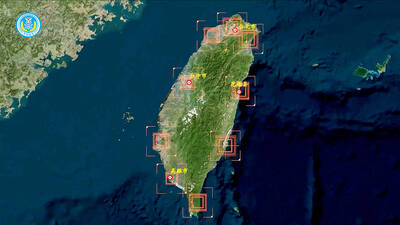
Shunxian Temple (順賢宮) is luxurious. Massive, exquisitely ornamented, in pristine condition and yet varnished by the passing of time. General manager Huang Wen-cheng (黃文正) points to a ceiling in a little anteroom: a splendid painting of a tiger stares at us from above. Wherever you walk, his eyes see

Mel May only realised she was different while reading a news article one day.“Wait, what? Some people hear a voice in their head?” she thought at the time. She was stunned to discover that this was not just a figure of speech — her friends were actually chatting to themselves in their minds.May, a 3

The 1990s were a turbulent time for the Chinese Nationalist Party’s (KMT) patronage factions. For a look at how they formed, check out the March 2 “Deep Dives.”In the boom years of the 1980s and 1990s the factions amassed fortunes from corruption, access to the levers of local government and prime a

Liking a co-worker’s photo on social media. Sending them direct messages. Checking in on Slack more often than before.Progressively interacting in this way with someone outside your relationship may be no big deal to you. To your significant other, however, it may be microcheating, which some people

The People’s Republic of China (PRC) last week offered us a glimpse of the violence it plans against Taiwan, with two days of blockade drills conducted around the nation and live-fire exercises not far away in the East China Sea. The PRC said it had practiced hitting “simulated targets of key ports

April 7 to April 13After spending over two years with the Republic of China (ROC) Army, A-Mei (阿美) boarded a ship in April 1947 bound for Taiwan. But instead of walking on board with his comrades, his roughly 5-tonne body was lifted using a cargo net.He wasn’t the only elephant; A-Lan (阿蘭) and A-P

Eric Finkelstein is a world record junkie. The American’s Guinness World Records include the largest flag mosaic made from table tennis balls, the longest table tennis serve and eating at the most Michelin-starred restaurants in 24 hours in New York.Many would probably share the opinion of Finkelste

On the lowest floor of the Taipei Fine Arts Museum (TFAM), a large room contains household items from coffee cans and wrapping paper to a mangled shopping cart. This is Lili Deli, the latest exhibition by multi-disciplinary artist Steph Huang (黃麗音). The London-based Huang deftly blends painting, pho

A vaccine to fight dementia? It turns out there may already be one — shots that prevent painful shingles also appear to protect aging brains.A new study found shingles vaccination cut older adults’ risk of developing dementia over the next seven years by 20 percent.The research, published Wednesday

Looking for an employee who’s ambitious, self-reliant and thinks outside the box? You might be fishing for a narcissist.A study by behavioral researchers looked at the corporate speak used in job postings and found that certain turns of phrase are catnip for those with, as a researcher puts it, “a g

If you’re hosting a dinner for half a dozen British intelligence agents with the aim of ferreting out a mole, what should you cook?For George Woodhouse (Michael Fassbender), who’s preparing for four colleagues, plus himself and his wife, Kathryn St. Jean (Cate Blanchett), who, like him, is a high-le

The star of The Friend has the loping stride of Robert Mitchum and the droopy, melancholy eyes of Peter Lorre. He has those classic Hollywood features — instantly accessible, forever unknowable — and when he walks down the street with his co-stars, Naomi Watts and Bill Murray, people’s heads turn.“P

Mother Nature gives and Mother Nature takes away. When it comes to scenic beauty, Hualien was dealt a winning hand. But one year ago today, a 7.2-magnitude earthquake wrecked the county’s number-one tourist attraction, Taroko Gorge in Taroko National Park. Then, in the second half of last year, two

In 2023, Emily Feng was one of a slew of reporters expelled from China, as the ruling Communist Party thinned the international press corps in retribution for coverage it deemed unflattering. Feng had started out in China in 2015 at age 22 as a researcher for the New York Times, then went on to writ

Up until 2020, Anna Wong had gone her entire adulthood in Los Angeles without ever facing blatantly racist abuse for being Asian. After COVID-19 hit, she was accosted twice in six months.The first time, she was browsing an aisle in Bed Bath & Beyond when a white, 30-something woman suddenly yelled:

For over half a century the Chinese Nationalist Party’s (KMT) patronage faction system remained fairly stable, but then quickly evolved with democratization. To understand these fascinating developments, we have to first understand how the system evolved in the first place. The KMT’s Republic of Chi

The baby was born in the aftermath of Myanmar’s earthquake and given to the flames of Buddhist funeral rites two days later, too young to have been named.The child’s pregnant mother was knocked over by the force of the quake while working in a paddy field, said grandmother Khin Myo Swe, and gave bir

Experts say that the devastating earthquake in Myanmar on Friday was likely the strongest to hit the country in decades, with disaster modeling suggesting thousands could be dead.Automatic assessments from the US Geological Survey (USGS) said the shallow 7.7-magnitude quake northwest of the central

In Uganda’s Mbale district, famous for its production of arabica coffee, a plague of plastic bags locally known as buveera is creeping beyond the city.It’s a problem that has long littered the landscape in Kampala, the capital, where buveera are woven into the fabric of daily life. They show up in l

Last week the Democratic Progressive Party (DPP) said that the budget cuts voted for by the China-aligned parties in the legislature, are intended to force the DPP to hike electricity rates. The public would then blame it for the rate hike.It’s fairly clear that the first part of that is correct. Sl
